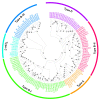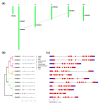Genome-Wide Survey and Expression Analyses of Hexokinase Family in Poplar (Populus trichocarpa)
- PMID: 35956502
- PMCID: PMC9370503
- DOI: 10.3390/plants11152025
Genome-Wide Survey and Expression Analyses of Hexokinase Family in Poplar (Populus trichocarpa)
Abstract
Hexokinase (HXK) family proteins exert critical roles in catalyzing hexose phosphorylation, sugar sensing, and modulation of plant growth and stress adaptation. Nevertheless, a large amount remains unknown about the molecular profile of HXK enzymes in Populus trichocarpa, a woody model tree species. A genome-wide survey of HXK-encoding genes, including phylogenies, genomic structures, exon/intron organization, chromosomal distribution, and conserved features, was conducted, identifying six putative HXK isogenes (PtHXK1-6) in the Populus genome. The evolutionary tree demonstrated that 135 homologous HXKs between 17 plant species were categorized into four major subfamilies (type A, B, C, and D), clustering one plastidic (PtHXK3) and five mitochondrial PtHXKs grouped into type A and B, respectively. The in silico deduction prompted the presence of the conserved sugar-binding core (motif 4), phosphorylation sites (motif 2 and 3), and adenosine-binding domains (motif 7). The transcriptomic sequencing (RNA-seq) and the quantitative real-time PCR (qRT-PCR) assays revealed that three isogenes (PtHXK2, 3, and 6) were abundantly expressed in leaves, stems, and roots, while others appeared to be dominantly expressed in the reproductive tissues. Under the stress exposure, PtHXK2 and 6 displayed a significant induction upon the pathogenic fungi (Fusarium solani) infection and marked promotions by glucose feeding in roots. In contrast, the PtHXK3 and 6 are ABA-responsive genes, following a dose-dependent manner. The comprehensive analyses of the genomic patterns and expression profiling provide theoretical clues and lay a foundation for unraveling the physiological and signaling roles underlying the fine-tuned PtHXKs responding to diverse stressors.
Keywords: Populus; hexokinase; stress and defense; sucrose metabolism; sugar signaling.
Conflict of interest statement
The authors declare no conflict of interest.
Figures






Similar articles
-
New Insight into Aspartate Metabolic Pathways in Populus: Linking the Root Responsive Isoenzymes with Amino Acid Biosynthesis during Incompatible Interactions of Fusarium solani.Int J Mol Sci. 2022 Jun 7;23(12):6368. doi: 10.3390/ijms23126368. Int J Mol Sci. 2022. PMID: 35742809 Free PMC article.
-
Integrative omics studies revealed synergistic link between sucrose metabolic isogenes and carbohydrates in poplar roots infected by Fusarium wilt.Plant Mol Biol. 2024 Mar 19;114(2):29. doi: 10.1007/s11103-024-01426-z. Plant Mol Biol. 2024. PMID: 38502380
-
Genome-wide identification, evolutionary expansion, and expression profile of homeodomain-leucine zipper gene family in poplar (Populus trichocarpa).PLoS One. 2012;7(2):e31149. doi: 10.1371/journal.pone.0031149. Epub 2012 Feb 16. PLoS One. 2012. PMID: 22359569 Free PMC article.
-
Structure, Expression, and Functional Analysis of the Hexokinase Gene Family in Cassava.Int J Mol Sci. 2017 May 12;18(5):1041. doi: 10.3390/ijms18051041. Int J Mol Sci. 2017. PMID: 28498327 Free PMC article.
-
Identification of hexokinase family members in pear (Pyrus × bretschneideri) and functional exploration of PbHXK1 in modulating sugar content and plant growth.Gene. 2019 Aug 30;711:143932. doi: 10.1016/j.gene.2019.06.022. Epub 2019 Jun 13. Gene. 2019. PMID: 31202905
Cited by
-
Complete plastid genome structure of 13 Asian Justicia (Acanthaceae) species: comparative genomics and phylogenetic analyses.BMC Plant Biol. 2023 Nov 15;23(1):564. doi: 10.1186/s12870-023-04532-0. BMC Plant Biol. 2023. PMID: 37964203 Free PMC article.
-
Editing Metabolism, Sex, and Microbiome: How Can We Help Poplar Resist Pathogens?Int J Mol Sci. 2024 Jan 21;25(2):1308. doi: 10.3390/ijms25021308. Int J Mol Sci. 2024. PMID: 38279306 Free PMC article. Review.
-
Identification and Expression Analysis of Hexokinases Family in Saccharum spontaneum L. under Drought and Cold Stresses.Plants (Basel). 2023 Mar 7;12(6):1215. doi: 10.3390/plants12061215. Plants (Basel). 2023. PMID: 36986904 Free PMC article.
-
10th Anniversary of Plants-Recent Advances and Further Perspectives.Plants (Basel). 2023 Apr 18;12(8):1696. doi: 10.3390/plants12081696. Plants (Basel). 2023. PMID: 37111918 Free PMC article.
-
Genome-Wide Identification and Expression Analysis of Hexokinase Gene Family Under Abiotic Stress in Tomato.Plants (Basel). 2025 Feb 3;14(3):441. doi: 10.3390/plants14030441. Plants (Basel). 2025. PMID: 39943003 Free PMC article.
References
-
- Claeyssen É., Dorion S., Clendenning A., He J.Z., Wally O., Chen J., Auslender E.L., Moisan M.-C., Jolicoeur M., Rivoal J. The Futile Cycling of Hexose Phosphates Could Account for the Fact That Hexokinase Exerts a High Control on Glucose Phosphorylation but Not on Glycolytic Rate in Transgenic Potato (Solanum tuberosum) Roots. PLoS ONE. 2013;8:e53898. doi: 10.1371/journal.pone.0053898. - DOI - PMC - PubMed
Grants and funding
LinkOut - more resources
Full Text Sources

